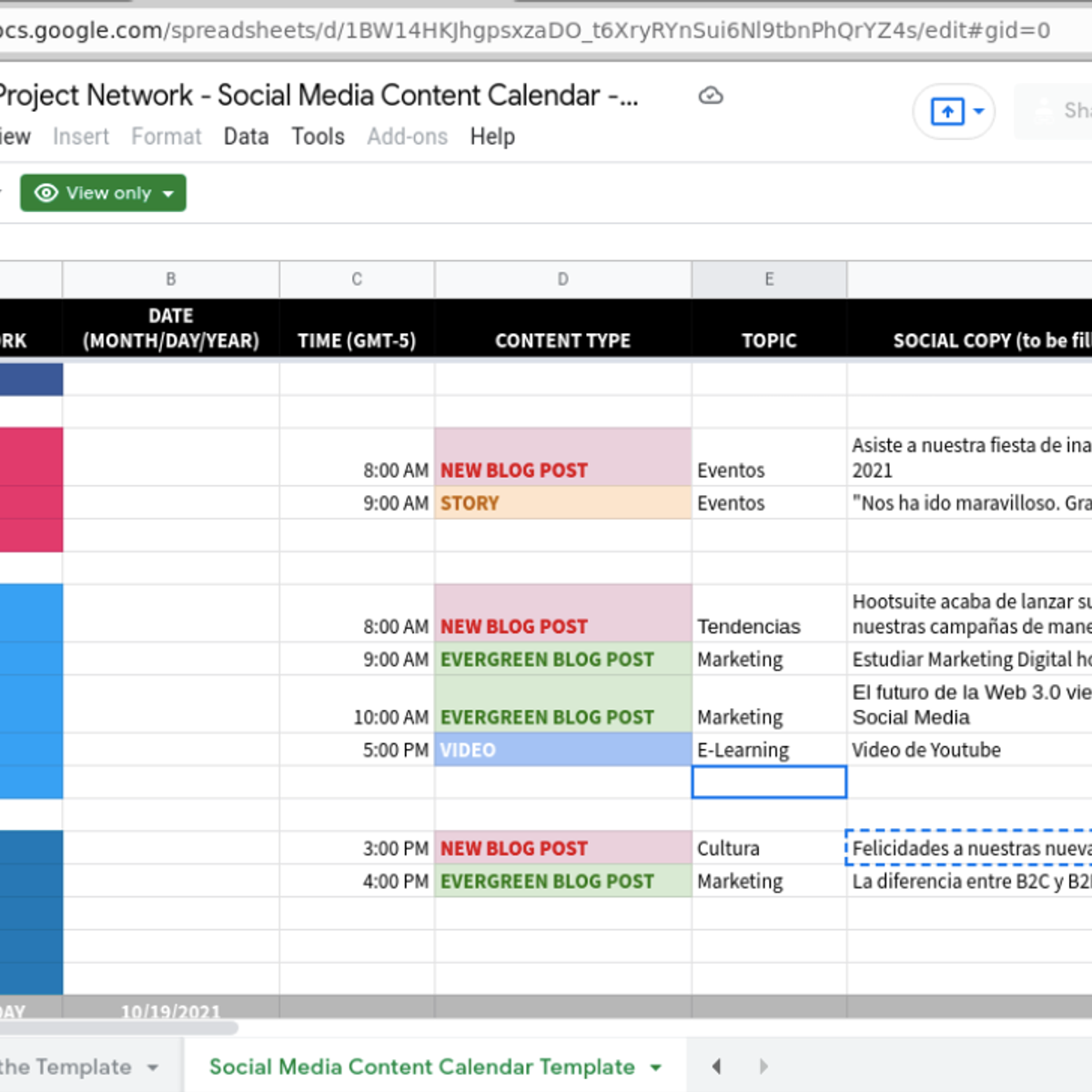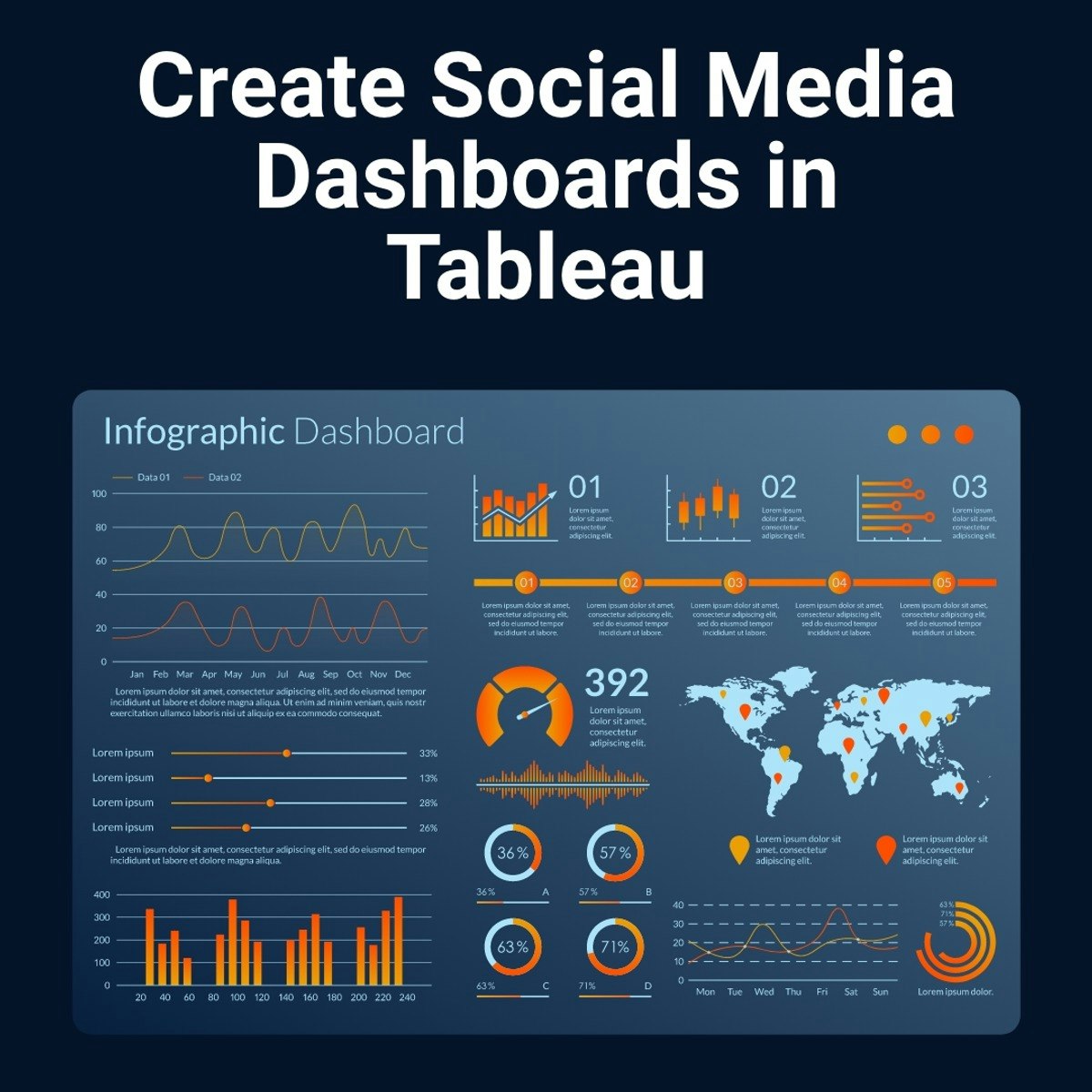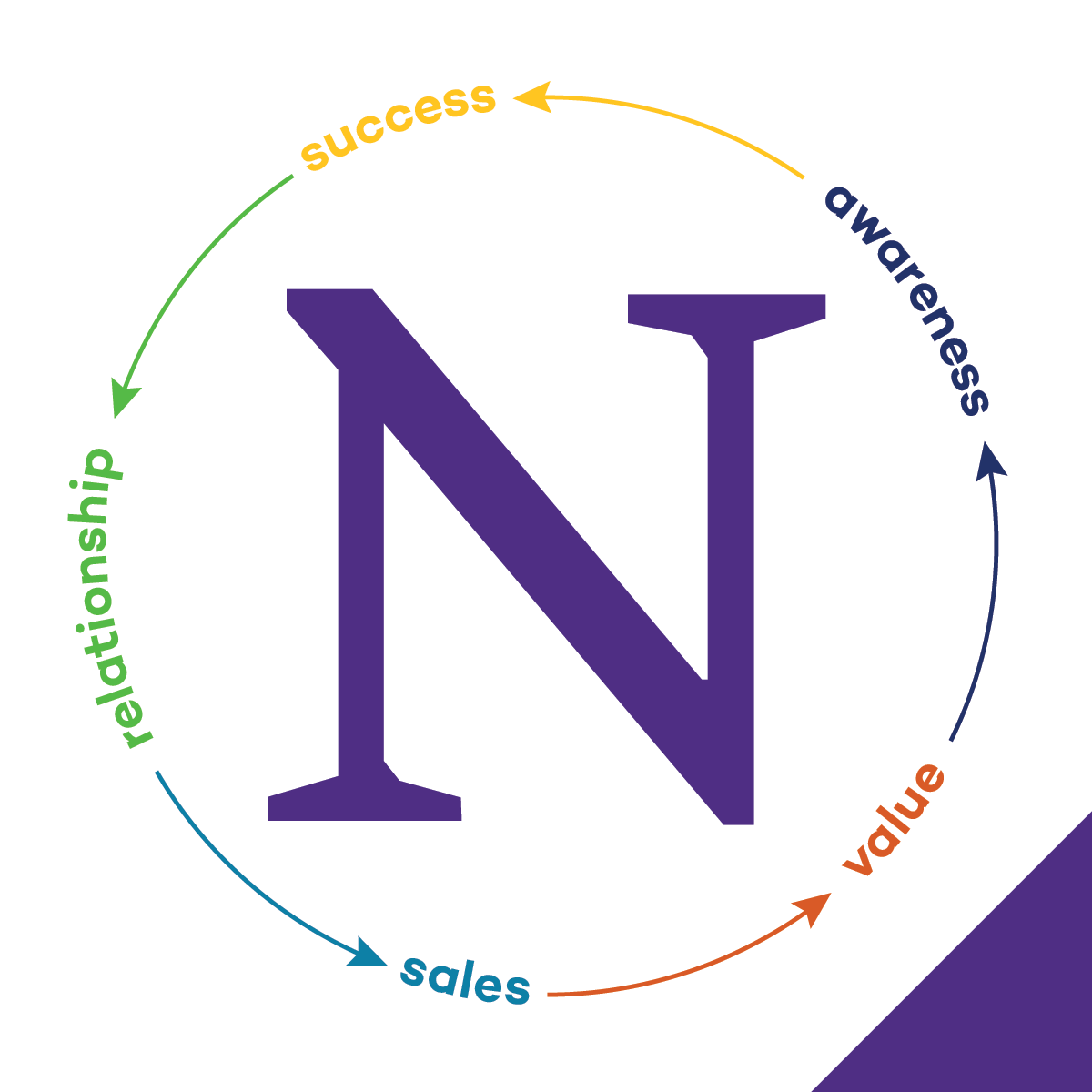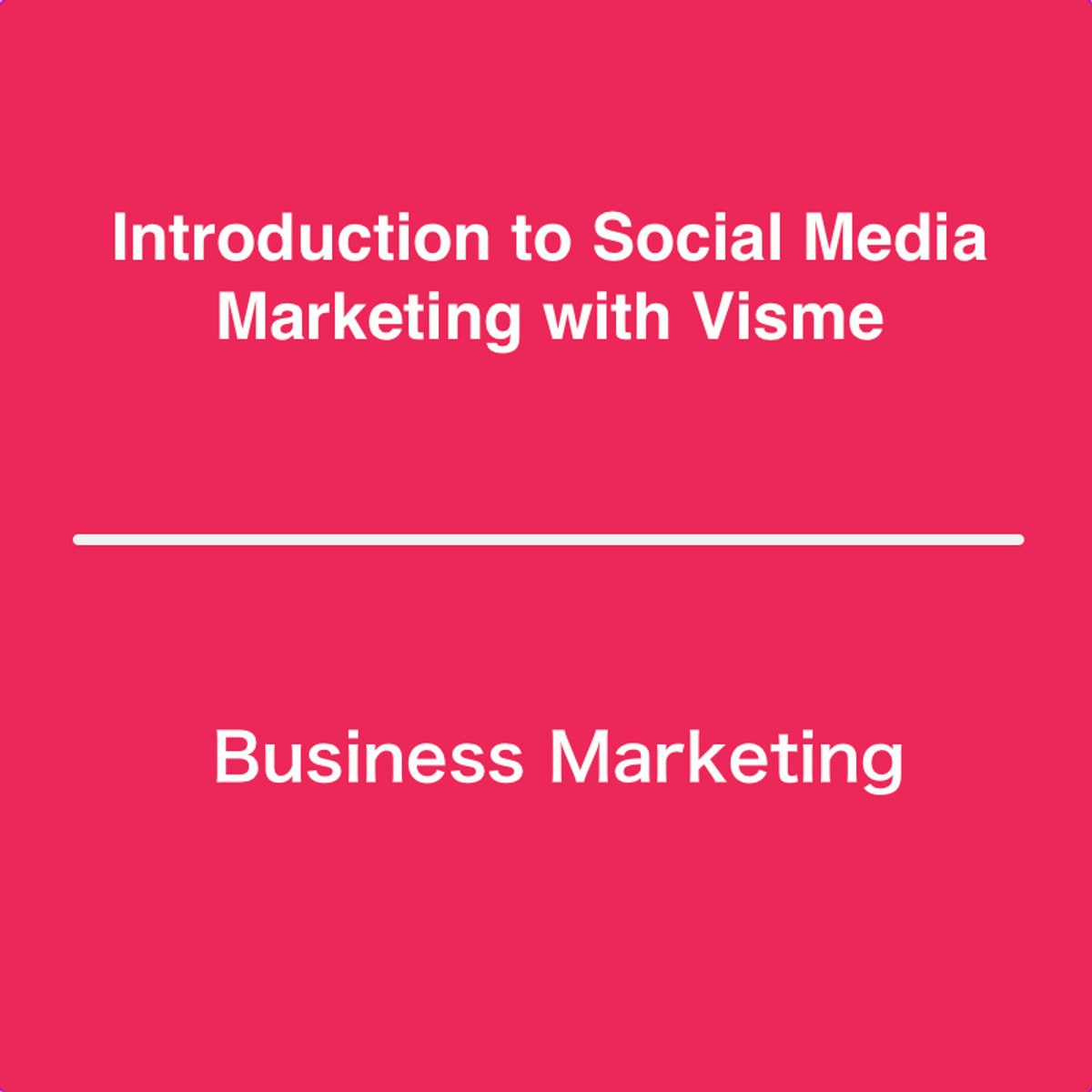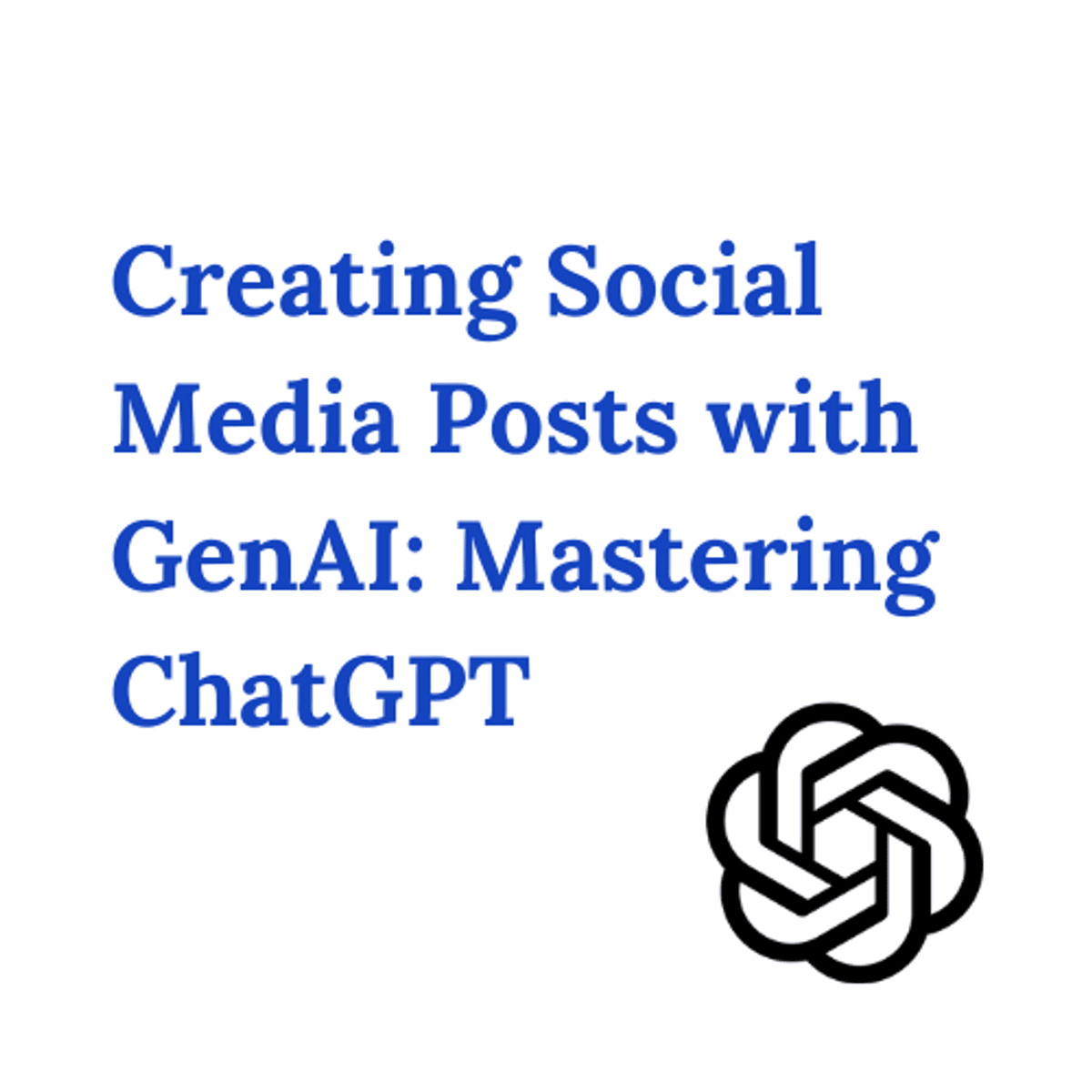Social Media Marketing
Introduction to Social Media Marketing
Social media marketing (SMM) is a form of digital marketing that involves creating and sharing content on social media networks to achieve marketing and branding goals. It encompasses activities like posting text and image updates, videos, and other content that drives audience engagement, as well as paid social media advertising. Fundamentally, it's about connecting with your audience, building brand awareness, increasing sales, and driving website traffic using platforms like Facebook, Instagram, X (formerly Twitter), LinkedIn, TikTok, and others.
Working in social media marketing can be quite engaging. It often involves a blend of creative content creation, strategic planning, and data analysis. You might find excitement in crafting compelling campaigns that capture attention, interacting directly with customers and building online communities, or analyzing metrics to understand what resonates with audiences and drives results. The field is constantly evolving with new platforms and features, offering continuous learning opportunities and the chance to experiment with innovative approaches to reach and engage people online.
Introduction to Social Media Marketing
Definition and Scope
Social media marketing utilizes social media platforms—websites and applications that enable users to create and share content or participate in social networking—to promote a product or service. The scope is broad, ranging from building brand awareness and fostering communities to generating leads and driving sales. It involves understanding various platforms, creating tailored content for each, managing online reputation, engaging with followers, analyzing performance data, and running targeted advertising campaigns.
The core idea is to meet target audiences where they spend a significant portion of their time online. With billions of people actively using social media globally, these platforms offer businesses unparalleled access to potential customers. Effective SMM requires a strategic approach, integrating content creation, community management, customer service, advertising, and analytics to achieve specific business objectives. It's not just about posting updates; it's about building relationships and driving measurable results.
The field encompasses both organic (unpaid) and paid strategies. Organic reach involves building an audience naturally through engaging content and interaction, while paid strategies use advertising features offered by platforms to target specific demographics and interests. A comprehensive SMM strategy typically blends both approaches to maximize reach and impact.
Historical Evolution and Key Milestones
The roots of social media marketing can be traced back to the earliest forms of online communities and bulletin board systems (BBS) in the late 20th century. However, the landscape dramatically changed with the rise of recognizable social networking sites like Six Degrees in 1997, followed by Friendster, MySpace, and LinkedIn in the early 2000s. These platforms laid the groundwork for online social interaction on a larger scale.
Facebook's launch in 2004 and Twitter's in 2006 marked significant milestones, rapidly attracting massive user bases and offering new ways for individuals and eventually businesses to connect. The introduction of Facebook Pages for businesses and early advertising options signaled the formal beginning of social media as a marketing channel. The subsequent rise of visually-focused platforms like Instagram (2010) and Pinterest (2010), video platforms like YouTube (2005) evolving into a social hub, and short-form video apps like TikTok (launched internationally in 2017) continuously reshaped strategies.
Key developments include the integration of sophisticated advertising platforms with detailed targeting capabilities, the rise of influencer marketing, the emphasis on video content, the growth of social commerce (buying products directly within social apps), and the increasing importance of algorithms in determining content visibility. The evolution is ongoing, driven by technological advancements, changing user behavior, and the emergence of new platforms.
Role in Modern Business and Communication
In modern business, social media marketing plays a pivotal role far beyond simple promotion. It serves as a primary channel for brand building, allowing companies to shape their identity, share their values, and tell their story directly to consumers. It's an essential tool for customer service, providing a direct line for communication, feedback collection, and issue resolution in real-time.
Social media is crucial for market research and understanding consumer sentiment. By monitoring conversations and analyzing trends, businesses gain valuable insights into customer needs, preferences, and pain points. This data informs product development, marketing messaging, and overall business strategy. Platforms like LinkedIn have also become indispensable for B2B marketing, networking, and talent acquisition.
Furthermore, SMM is integral to driving website traffic, generating leads, and boosting sales, particularly with the growth of social commerce features. It allows businesses to build and nurture communities around their brand, fostering loyalty and turning customers into advocates. In essence, social media has become a fundamental component of integrated marketing communications, impacting nearly every aspect of how businesses interact with their stakeholders.
Key Industries Leveraging Social Media Marketing
Virtually every industry today utilizes social media marketing in some capacity, but its application and impact vary. The retail and e-commerce sectors heavily rely on platforms like Instagram, Pinterest, and Facebook for visual product discovery, influencer collaborations, targeted advertising, and direct sales through social commerce features.
The entertainment and media industries use social media extensively to promote movies, TV shows, music, and events, engage with fans, share behind-the-scenes content, and build buzz. Travel and hospitality businesses leverage platforms like Instagram and Facebook to showcase destinations, share user-generated content, offer deals, and provide customer service. The food and beverage industry uses visually appealing content on platforms like Instagram and TikTok to attract customers, run promotions, and engage with food bloggers and influencers.
Technology companies utilize platforms like LinkedIn and X (formerly Twitter) for B2B marketing, thought leadership, product announcements, and customer support. Healthcare organizations and non-profits use social media for public health campaigns, awareness initiatives, community building, and fundraising. Even heavily regulated industries like finance and government are increasingly using social media for communication, customer service, and disseminating information, albeit with specific compliance considerations.
Core Concepts of Social Media Marketing
Audience Segmentation and Targeting
Audience segmentation is the process of dividing a broad target audience into smaller, more defined groups based on shared characteristics. These characteristics can include demographics (age, gender, location, income, education), psychographics (lifestyle, interests, values, attitudes), and behavior (purchase history, online activity, platform usage). The goal is to understand the different needs and preferences within your potential customer base.
Targeting involves selecting specific segments to focus your marketing efforts on. Social media platforms offer powerful targeting tools for advertisers, allowing businesses to reach users based on detailed criteria. For example, you can target ads to users in a specific city, who have shown interest in hiking, and are within a certain age range. Effective targeting ensures that marketing messages reach the most relevant audience, increasing the efficiency and effectiveness of campaigns.
Understanding your audience is fundamental to successful SMM. By segmenting your audience and targeting your messages appropriately, you can create more personalized and relevant content that resonates better, leads to higher engagement rates, and ultimately drives better business results. This requires ongoing analysis and refinement as audience behaviors and platform capabilities evolve.
Content Types (Organic vs. Paid)
Social media content can be broadly categorized into organic and paid. Organic content refers to any post (text, image, video, story, etc.) shared on a social media profile that is not promoted through paid advertising. Its reach is determined primarily by the platform's algorithm, the size and engagement of your existing audience, and the quality and relevance of the content itself.
Organic content is crucial for building relationships, fostering community, providing value, and maintaining a consistent brand presence. Examples include regular updates, behind-the-scenes glimpses, educational posts, user-generated content features, and customer interactions. While often perceived as "free," creating high-quality organic content requires time, effort, and creative resources.
Paid content, or social media advertising, involves paying the platform to promote specific posts or run dedicated ad campaigns to reach a wider or more specific audience beyond your existing followers. Paid social allows for precise targeting based on demographics, interests, behaviors, and more. It's highly effective for achieving specific goals quickly, such as driving website traffic, generating leads, increasing brand awareness among new audiences, or promoting specific products or offers. Most comprehensive SMM strategies utilize a mix of both organic and paid content to achieve different objectives.
Engagement Metrics
Engagement metrics are key performance indicators (KPIs) used to measure how audiences are interacting with your social media content. These metrics help gauge the effectiveness of your content strategy and understand audience interest. Common engagement metrics include likes (or reactions), comments, shares, saves, clicks (including link clicks), profile visits, mentions, and direct messages.
Different metrics hold varying levels of significance depending on campaign goals. Likes indicate basic approval, while comments suggest a higher level of interaction and thought. Shares amplify reach by distributing your content to new audiences through users' networks. Clicks, especially link clicks (often measured as Click-Through Rate or CTR), are crucial for driving traffic to a website or landing page. Saves (common on platforms like Instagram and Pinterest) indicate that users find the content valuable enough to revisit later.
Analyzing these metrics provides valuable feedback. High engagement often signals that content is relevant and resonates with the audience, while low engagement might indicate a need to adjust content strategy, timing, or targeting. Tracking these metrics over time helps optimize performance and demonstrate the ROI of social media efforts.
These courses provide a solid foundation in understanding and utilizing social media metrics and analytics.
Platform-Specific Algorithms
Social media algorithms are complex sets of rules and calculations that platforms use to decide which content appears in a user's feed, in what order, and how prominently. Each platform (Facebook, Instagram, TikTok, LinkedIn, X, etc.) has its own unique algorithm designed to maximize user engagement and time spent on the platform.
These algorithms consider numerous factors, including user behavior (past interactions, accounts followed, time spent on posts), content characteristics (type, recency, engagement received), and relationships between users. For example, Instagram's algorithm prioritizes content from accounts a user interacts with frequently, while TikTok's algorithm heavily emphasizes content engagement signals (likes, shares, comments, watch time) to determine virality, often showing content from accounts a user doesn't follow.
Understanding the nuances of each platform's algorithm is crucial for social media marketers. Strategies need to be tailored to align with how each algorithm works to maximize organic reach and visibility. This often involves creating platform-native content, encouraging specific types of engagement, posting at optimal times, and staying updated on frequent algorithm changes announced by the platforms. Failure to adapt can lead to significantly reduced visibility for organic content.
Strategies and Campaign Design
Campaign Planning and Goal-Setting (SMART Goals)
Effective social media marketing starts with strategic planning. A campaign plan outlines the objectives, target audience, key messages, content strategy, platforms, timeline, budget, and measurement metrics for a specific marketing initiative. Without a plan, efforts can become scattered and difficult to evaluate.
A critical part of planning is setting clear, measurable goals. The SMART framework is widely used for this purpose: Goals should be Specific (clearly defined), Measurable (quantifiable), Achievable (realistic), Relevant (aligned with overall business objectives), and Time-bound (having a defined deadline). Examples of SMART goals in SMM could be "Increase Instagram engagement rate by 15% among women aged 25-34 within the next quarter" or "Generate 500 qualified leads for Product X through LinkedIn ads by the end of the month with a budget of $2000."
Setting SMART goals provides direction for the campaign, helps allocate resources effectively, and establishes clear benchmarks for measuring success. It forces marketers to think critically about what they want to achieve and how they will know if they've succeeded, moving beyond vague objectives like "increase brand awareness" to concrete, trackable targets.
These courses offer insights into planning and executing successful social media strategies and campaigns.
Content Calendars and Scheduling Tools
A content calendar is a planning tool used to schedule social media posts in advance. It typically includes details such as the date and time of posting, the platform, the specific content (text, visual, link), campaign relevance, and any associated hashtags or mentions. Content calendars help ensure a consistent posting schedule, align content with overall marketing goals and events, prevent last-minute scrambling, and facilitate collaboration within a team.
Maintaining consistency is vital for audience engagement and algorithm favourability. A well-planned calendar allows marketers to map out content themes, balance promotional posts with valuable or entertaining content, and tailor messages for different platforms strategically over time. It provides a visual overview of the content plan, making it easier to manage and adjust.
Scheduling tools are software applications that allow marketers to upload and schedule posts to be published automatically at predetermined times across multiple social media platforms. Popular tools include Hootsuite, Buffer, Sprout Social, and Later. These tools streamline the posting process, save significant time, enable posting outside of working hours for optimal reach, and often provide analytics features to track performance. Using scheduling tools in conjunction with a content calendar is standard practice for efficient social media management.
The following courses can help you learn about content planning and scheduling tools.
Influencer Collaboration Frameworks
Influencer marketing involves collaborating with individuals who have a dedicated following and credibility within a specific niche or industry to promote a brand, product, or service. These individuals, known as influencers, can range from celebrities with massive followings (macro-influencers) to individuals with smaller, highly engaged audiences in specific niches (micro-influencers or nano-influencers).
Developing a framework for collaboration is essential for successful influencer marketing. This framework typically involves identifying relevant influencers whose audience aligns with the brand's target market, vetting influencers for authenticity and engagement rates, defining clear campaign goals and expectations, negotiating compensation (monetary payment, free products, commission, etc.), establishing content guidelines while allowing for creative freedom, ensuring compliance with disclosure regulations (e.g., clearly marking sponsored posts), and tracking performance metrics.
Working with local influencers who understand cultural nuances can be particularly effective for global campaigns. While influencer marketing can be highly effective for building trust, reaching new audiences, and driving conversions, it requires careful planning and management to ensure authenticity, transparency, and a positive return on investment. The focus is shifting towards genuine partnerships rather than simple transactional endorsements.
This book offers insights into using content effectively, a key aspect of influencer collaborations.
Crisis Management Protocols
Social media's real-time nature means that negative feedback, misinformation, or brand crises can spread rapidly. Having a social media crisis management protocol in place is crucial for responding effectively and mitigating potential damage to brand reputation. This protocol is a predefined plan outlining how the organization will handle negative situations or crises that emerge on social media.
Key components of a crisis management protocol include: identifying potential crisis scenarios (e.g., product recalls, negative reviews going viral, employee misconduct, data breaches, public criticism), establishing a clear chain of command and roles for response, setting up monitoring tools to detect potential issues early (social listening), defining response procedures (when and how to respond publicly vs. privately), crafting pre-approved messaging templates for common scenarios, designating official spokespeople, and outlining procedures for escalating issues internally.
The protocol should emphasize timely, transparent, and empathetic communication. A swift and well-handled response can often turn a potential crisis into an opportunity to demonstrate accountability and build trust, while a poor or delayed response can exacerbate the situation significantly. Regular review and updating of the protocol are necessary to keep it relevant.
Platforms and Tools
Comparative Analysis of Major Platforms
Different social media platforms cater to distinct audiences and content formats, requiring tailored strategies. Facebook remains the largest platform globally, with a diverse user base, making it versatile for community building, advertising, and customer service. Instagram, owned by Meta, is highly visual, ideal for brands in fashion, beauty, food, travel, and e-commerce, leveraging photos, Reels (short-form video), and Stories.
X (formerly Twitter) is a real-time platform focused on news, conversations, and customer service interactions, often used for brand announcements and public relations. LinkedIn is the primary platform for B2B marketing, professional networking, thought leadership, and recruitment. TikTok has surged in popularity, particularly among younger demographics (Gen Z), driven by short-form, entertaining video content and powerful trend cycles. YouTube is the dominant platform for long-form video content, tutorials, reviews, and entertainment, also incorporating social features.
Choosing the right platforms depends on the target audience, marketing goals, and content type. Most brands maintain a presence on multiple platforms, but tailor their content and strategy for each, recognizing their unique strengths and user expectations. For example, a B2B software company might focus heavily on LinkedIn for lead generation, while a fashion retailer might prioritize Instagram and TikTok for visual appeal and trend engagement.
Explore the nuances of different platforms with these resources.
Automation Tools
Social media automation involves using software tools to perform certain tasks without direct human intervention. This can significantly improve efficiency, consistency, and scalability of social media efforts. Common tasks automated include scheduling posts across multiple platforms, monitoring brand mentions and keywords, generating basic performance reports, and sometimes, engaging in simple interactions like liking posts or following users (though automated engagement requires caution).
Popular automation and management tools like Hootsuite, Buffer, Sprout Social, and Agorapulse offer dashboards to manage multiple accounts, schedule content from a calendar, collaborate with team members, and track analytics. These platforms centralize management, saving marketers from logging into each platform individually. Some tools also offer social listening features, helping track brand sentiment and identify relevant conversations.
While automation is valuable for efficiency, it's crucial to maintain authenticity and human interaction. Over-reliance on automation, especially for direct communication or responses, can appear impersonal and damage brand perception. The best approach balances automation for routine tasks (like scheduling approved content) with genuine human engagement for conversations, customer service, and community building.
Consider these books for strategic insights that complement tool usage.
Analytics Dashboards
Analytics dashboards are tools that consolidate data from various social media platforms into a single interface, providing a comprehensive overview of performance. They track key metrics like reach, engagement, follower growth, demographics, website traffic referrals, and conversion rates, often presenting the data through charts, graphs, and customizable reports.
Platforms like Google Analytics track website traffic originating from social media, helping measure the effectiveness of SMM in driving off-platform actions. Native analytics within each social media platform (e.g., Facebook Insights, Instagram Insights, TikTok Analytics) provide platform-specific data. Third-party social media management tools (Hootsuite, Sprout Social, Buffer, etc.) often include integrated analytics dashboards that pull data from multiple platforms, offering cross-channel comparisons and reporting.
These dashboards are essential for monitoring campaign performance against goals, identifying high-performing content, understanding audience behavior, optimizing strategies, and demonstrating the ROI of social media activities to stakeholders. Regularly reviewing analytics data allows marketers to make informed, data-driven decisions rather than relying on guesswork.
These courses delve into the analytical side of social media.
Emerging Platforms and Niche Communities
The social media landscape is constantly evolving, with new platforms emerging and niche communities gaining traction. While established giants like Facebook and Instagram remain dominant, platforms catering to specific interests, demographics, or technologies are carving out significant user bases. Examples include Discord (popular for gaming and interest-based communities), Twitch (live-streaming, primarily gaming), BeReal (focused on authenticity), and newer decentralized platforms like Mastodon and Bluesky gaining attention due to privacy concerns on centralized platforms.
Niche communities often form within larger platforms (like specific Subreddits or Facebook Groups) or on dedicated forums and apps. These communities offer highly engaged audiences centered around specific topics, hobbies, or identities. Marketing within these spaces requires a deep understanding of the community's culture, norms, and communication style, often prioritizing genuine participation and value contribution over direct promotion.
Staying aware of emerging platforms and niche communities allows marketers to identify new opportunities to reach target audiences, experiment with innovative formats, and connect with highly engaged users. Early adoption, when appropriate, can provide a competitive advantage. However, it requires careful evaluation to ensure the platform aligns with brand goals and target demographics before investing significant resources.
Consider exploring these related topics and careers.
Ethical Considerations in Social Media Marketing
Data Privacy and GDPR Compliance
Social media marketing often involves collecting and utilizing user data for targeting and personalization. This raises significant ethical concerns regarding data privacy. Users are increasingly aware of and concerned about how their personal information is collected, stored, and used by platforms and advertisers. Breaches of trust can lead to severe reputational damage.
Regulations like the General Data Protection Regulation (GDPR) in Europe and similar laws in other regions (like the California Consumer Privacy Act - CCPA) impose strict rules on data collection and usage. These regulations typically require user consent for data processing, grant users rights to access and delete their data, and mandate transparency about data practices. Marketers must ensure their activities, including ad targeting and data collection methods (like tracking pixels), comply with these legal requirements.
Ethical data handling goes beyond legal compliance. It involves being transparent with users about data usage, providing clear opt-out mechanisms, minimizing data collection to what is necessary, and ensuring data security. Prioritizing user privacy builds trust and fosters a more positive brand image in the long run.
Misinformation and Content Moderation
The rapid spread of information on social media also facilitates the dissemination of misinformation (false information spread unintentionally) and disinformation (false information spread intentionally to deceive). This can harm individuals, public health, democratic processes, and brand reputation if a brand's content or ads appear alongside problematic material or if the brand itself inadvertently shares inaccurate information.
Content moderation, the process platforms use to review and remove content that violates their policies, is a complex and controversial challenge. Marketers have an ethical responsibility to ensure the accuracy of the information they share and to avoid contributing to the spread of harmful content. This includes fact-checking claims, citing credible sources, and being mindful of the context in which their content appears.
Brands must also be prepared to address misinformation related to their products or industry responsibly. This might involve proactively sharing accurate information, correcting falsehoods clearly and transparently, and reporting harmful content to the platforms. Engaging ethically means contributing positively to the information ecosystem, not exploiting sensationalism or ambiguity.
Mental Health Impacts of Targeted Advertising
The sophisticated targeting capabilities of social media advertising, while effective for marketers, raise ethical questions about their potential impact on users' mental health. Constant exposure to idealized lifestyles, hyper-personalized ads exploiting insecurities (e.g., related to body image, financial status), and the addictive nature of algorithmically curated feeds can contribute to anxiety, depression, comparison, and low self-esteem.
Ethical considerations involve questioning whether certain targeting practices prey on vulnerabilities. For example, targeting weight loss products to users who have shown interest in body positivity content, or targeting gambling ads to users exhibiting potential addiction behaviors, could be seen as exploitative. Marketers need to reflect on the potential psychological impact of their campaigns.
Responsible marketing involves avoiding manipulative tactics, promoting positive messages, being sensitive in ad creative and targeting, and respecting user well-being. This includes offering easy opt-outs from sensitive ad topics and ensuring campaigns do not contribute negatively to mental health dialogues. The focus should be on providing value and solutions, not exploiting anxieties.
Greenwashing and Ethical Branding
As consumers increasingly prioritize sustainability, many brands highlight their eco-friendly practices in their marketing. Greenwashing occurs when a company deceptively markets its products or policies as environmentally friendly when they are not, or exaggerates its positive environmental impact. This is an unethical practice that misleads consumers and erodes trust.
Ethical branding in the context of sustainability requires transparency and honesty. Claims about environmental benefits must be accurate, specific, and substantiated. Brands should avoid vague terms like "eco-friendly" without clear evidence and be transparent about their overall environmental footprint, not just cherry-picking positive aspects. True sustainable marketing involves genuine commitment to reducing environmental impact across the business, not just using green themes in advertising.
Social media marketers play a role in ensuring communication about sustainability is truthful and avoids greenwashing. This builds long-term brand credibility and aligns with the values of environmentally conscious consumers. Misleading claims, once exposed, can lead to significant backlash and reputational damage.
Career Pathways and Professional Development
Entry-Level Roles
For those starting in social media marketing, several entry-level roles provide foundational experience. A Social Media Coordinator often assists with daily tasks like scheduling posts, monitoring comments, responding to basic inquiries, and compiling simple reports. They work under the guidance of more senior managers, learning the ropes of platform management and content execution. [5pgivj]
A Content Creator role focuses specifically on producing the assets used in social media campaigns – writing copy, designing graphics, shooting photos, or editing videos. While sometimes overlapping with coordinator roles, this position emphasizes creative production skills tailored for different platforms. [2pc6g3]
Other entry points might include roles like Community Moderator (focused on engaging with the audience and enforcing community guidelines) or Digital Marketing Assistant (a broader role that includes some social media responsibilities). These positions typically require strong communication skills, familiarity with major social media platforms, creativity, and organizational abilities. While a degree can be helpful, practical experience, a strong portfolio, and demonstrated platform knowledge are often highly valued.
These introductory courses are great starting points for aspiring social media professionals.
Mid-Career Specializations
As professionals gain experience in social media marketing, they often specialize in specific areas requiring deeper expertise. A Social Media Strategist focuses on high-level planning, developing overarching strategies aligned with business goals, analyzing market trends, defining target audiences, and setting campaign objectives. They guide the overall direction of the brand's social media presence. [g2747z]
A Paid Ads Specialist (or Social Media Advertising Specialist) concentrates on managing paid advertising campaigns across platforms like Facebook, Instagram, LinkedIn, etc. This involves budget management, audience targeting, ad creative development, A/B testing, performance analysis, and optimizing campaigns for ROI. [h7elm3, a3sjmr] This role requires strong analytical skills and a deep understanding of platform ad tools.
Other specializations include Social Media Analyst (focused on data analysis and reporting), Community Manager (focused on building and nurturing online communities), SEO Specialist with social media expertise (integrating search and social strategies), or Content Marketing Manager with a strong social focus. These roles typically require several years of experience and demonstrated success in their specific domain.
These items explore strategic aspects relevant to mid-career professionals.
Leadership Roles
With significant experience and demonstrated leadership capabilities, social media professionals can advance into management and executive roles. A Social Media Manager typically oversees the social media team (coordinators, content creators), develops and executes strategies, manages budgets, reports on performance to leadership, and ensures consistency across all social channels. [g5sywu]
A Head of Social Media or Social Media Director takes on a more strategic leadership role, often setting the vision for the brand's social media presence, integrating social strategy with overall marketing and business goals, managing larger teams and budgets, overseeing agency relationships, and representing social media at the executive level. These roles require strong strategic thinking, leadership skills, budget management experience, and a deep understanding of the evolving digital landscape.
In some organizations, social media leadership might fall under broader titles like Head of Digital Marketing or Chief Marketing Officer (CMO), where social media is one component of a larger digital or overall marketing strategy. Advancement often involves a proven track record of achieving business results through social media, strong analytical capabilities, and excellent communication and leadership skills.
Explore management and broader marketing concepts with these resources.
Freelancing and Entrepreneurship Opportunities
Social media marketing offers significant opportunities for freelancing and entrepreneurship. Many businesses, particularly small and medium-sized ones, lack the internal resources or expertise to manage their social media effectively and thus hire freelance social media managers or consultants. Freelancers might offer services ranging from content creation and scheduling to full strategy development and campaign management. [xon579, 2wycvv]
Building a successful freelance career requires not only strong SMM skills but also business acumen: client acquisition, proposal writing, contract negotiation, project management, invoicing, and self-marketing. Platforms like Upwork or Fiverr can provide initial opportunities, but building a personal brand and network is often key to long-term success.
Entrepreneurial paths include starting a dedicated social media marketing agency, developing specialized SMM software or tools, or creating and monetizing content as an influencer or educator in the SMM space. These ventures require a higher degree of risk-taking, business planning, and potentially investment, but offer the rewards of building one's own enterprise. [erg0yl]
These courses offer perspectives on running a social media business or freelancing.
Education and Certification Pathways
University Degrees
While not always strictly required, a university degree in a relevant field can provide a strong theoretical foundation and valuable skills for a career in social media marketing. Degrees in Marketing are perhaps the most directly applicable, covering core principles of market research, consumer behavior, branding, advertising, and strategic planning.
Degrees in Communications or Public Relations are also highly relevant, emphasizing writing skills, message crafting, audience analysis, media relations, and reputation management – all crucial aspects of SMM. Journalism degrees can hone storytelling, content creation, and ethical reporting skills.
Other related fields include Business Administration (providing a broader business context), Graphic Design (for visually focused roles), or even Psychology or Sociology (for understanding user behavior). A degree can be advantageous for securing entry-level positions in larger organizations or for roles requiring deep strategic thinking, but practical skills and portfolio work are often equally, if not more, important, especially in demonstrating proficiency with specific platforms and tools.
Certifications
Certifications offer a way to demonstrate specialized knowledge and skills in specific areas of social media marketing, often acquired more quickly than a full degree. Many platforms offer their own certifications, such as the Meta Blueprint certifications (covering Facebook and Instagram advertising and marketing) or certifications from Google related to digital marketing and analytics (like Google Analytics).
Industry organizations and educational platforms also offer certifications in social media marketing, digital marketing, content marketing, or specific tools (like Hootsuite certifications). These programs often cover best practices, platform features, strategy development, and analytics. While the value placed on certifications can vary among employers, they can be a valuable addition to a resume, especially for career changers or those without extensive formal experience.
Completing certifications shows initiative, commitment to professional development, and proficiency in specific tools or platforms. They can help bridge skill gaps and make a candidate more competitive in the job market. It's advisable to research the reputation and industry recognition of a certification before investing time and money.
Consider these comprehensive certification programs or courses that cover certification material.
Self-paced Online Courses and Bootcamps
Online courses and bootcamps have become increasingly popular and effective pathways for learning social media marketing skills. Platforms like OpenCourser aggregate offerings from various providers such as Coursera, edX, Udacity, and Udemy, featuring courses taught by university professors and industry experts. These courses cover everything from introductory concepts to advanced strategies and platform-specific tactics.
Self-paced online courses offer flexibility, allowing learners to study around existing commitments. They often focus on practical, job-ready skills and may include hands-on projects. Bootcamps provide a more intensive, structured learning experience over a shorter period, often designed to quickly equip individuals with the skills needed for an entry-level role. Many online courses also offer certificates upon completion, which can be added to resumes and LinkedIn profiles.
Online learning is an excellent option for individuals seeking to enter the field without a traditional degree, professionals looking to upskill or specialize, or those wanting to stay current with the rapidly evolving digital landscape. OpenCourser's Learner's Guide provides resources on how to effectively structure self-learning and make the most of online educational materials.
Here is a selection of online courses covering various aspects of social media marketing:
Portfolio-Building Through Personal Projects
Regardless of the educational path chosen, building a strong portfolio is essential for demonstrating practical skills to potential employers or clients. A portfolio showcases your ability to create engaging content, run campaigns, and achieve results. Personal projects are an excellent way to build this portfolio, especially for those lacking formal work experience.
You can start by creating and managing social media accounts for a personal brand, a passion project, a fictional business, or even a local community group or non-profit on a volunteer basis. Document your process: define objectives, create a content calendar, design posts, write copy, run small ad campaigns (if budget allows), track metrics, and analyze results. Take screenshots, save examples of your best work, and write case studies summarizing your approach and outcomes.
Include a variety of work in your portfolio, showcasing skills across different platforms and content types (graphics, video, writing). Highlight specific achievements, such as follower growth, engagement rate increases, or successful ad campaigns. A well-curated portfolio provides tangible proof of your capabilities and can often be more persuasive than qualifications alone.
These project-based courses allow hands-on experience perfect for portfolio building.
Global Trends and Market Dynamics
Regional Platform Preferences
While platforms like Facebook, Instagram, and YouTube have massive global reach, social media usage varies significantly by region. Understanding these preferences is crucial for effective international marketing. For example, in China, platforms like WeChat (a multi-purpose messaging, social media, and mobile payment app) and Weibo (a microblogging site) dominate, as many Western platforms are blocked or less popular.
In other parts of Asia, platforms like Line (popular in Japan, Thailand, Taiwan) or KakaoTalk (South Korea) are key communication and social hubs. Russia has VK (VKontakte) as a dominant domestic platform. While global platforms are widely used in Europe, North America, and Latin America, specific usage patterns and preferred content types can still differ.
Marketers targeting specific regions must research which platforms are most popular among their target demographic in that area. A strategy heavily reliant on Instagram might be effective in the US but less so in a market where a different platform holds sway. Adapting platform choice is a fundamental step in global social media strategy.
Cultural Adaptation of Campaigns
Effective global social media marketing requires more than just translating content; it necessitates cultural adaptation, also known as localization. This involves tailoring messaging, visuals, themes, and tone to resonate with the specific cultural norms, values, and preferences of the target audience in each market.
Cultural adaptation considers factors like language nuances (idioms, slang, formality levels), color symbolism (colors can have vastly different meanings across cultures), imagery appropriateness, local customs and traditions, religious sensitivities, and communication styles (direct vs. indirect). A campaign that is successful in one culture might be ineffective or even offensive in another if not properly adapted.
Strategies for cultural adaptation include conducting thorough market research, consulting with local experts or teams, using culturally appropriate visuals and symbols, adapting humor and storytelling approaches, and potentially collaborating with local influencers who understand the cultural context deeply. Respecting cultural differences builds trust and makes marketing messages more relevant and impactful.
Impact of Geopolitical Events on Digital Marketing
Geopolitical events, such as international conflicts, trade disputes, political instability, and regulatory changes (like data localization laws), can significantly impact digital and social media marketing strategies. These events can disrupt supply chains, alter consumer sentiment and trust, create economic uncertainty affecting spending, and lead to changes in platform accessibility or regulations.
Brands may need to adapt their messaging to be sensitive to ongoing events, potentially pausing campaigns or shifting tone. Political tensions can lead to consumer boycotts or negative sentiment towards brands associated with certain countries or political stances. Trade disputes or tariffs can affect pricing and product availability, requiring adjustments in marketing communications. Furthermore, increasing focus on 'digital sovereignty' can create challenges for global platforms and advertisers relying on cross-border data flows.
Marketers need to stay informed about geopolitical developments and be prepared to adapt their strategies quickly. This might involve diversifying markets, localizing campaigns more heavily, focusing on building community and trust, and prioritizing agility in planning and execution. Geopolitical instability often leads marketers to be more cautious with budgets and focus on near-term, measurable goals like demand generation.
Emerging Markets and Growth Opportunities
Emerging markets across Asia, Africa, Latin America, and Eastern Europe represent significant growth opportunities for social media marketing. These regions often have rapidly growing internet penetration rates, increasing smartphone adoption, and young, digitally-savvy populations eager to engage on social media.
While infrastructure and platform accessibility can sometimes pose challenges, the potential for reaching large, untapped audiences is substantial. Success in these markets requires a deep understanding of local culture, language, economic conditions, and preferred social media platforms, which may differ from established Western markets. Mobile-first strategies are often essential, given the prevalence of smartphone internet access.
Brands entering emerging markets should focus on building trust, providing value relevant to local needs, and potentially partnering with local influencers or businesses. Strategies may need to be adapted for lower bandwidth environments or different pricing sensitivities. Investing in understanding and catering to these diverse and dynamic markets can unlock significant long-term growth.
Future of Social Media Marketing
AI-Generated Content and Deepfakes
Artificial intelligence (AI) is increasingly integrated into social media marketing, particularly for content creation. AI tools can now generate text (captions, posts, articles), images, and even video content, potentially streamlining production and enabling hyper-personalization at scale. Many marketers are already using AI for tasks like drafting posts, brainstorming ideas, and creating visual variations.
In 2025 and beyond, AI's role in content generation is expected to become standard practice. AI can analyze data to predict trends and optimize content performance. However, the rise of AI also brings challenges, notably the potential for AI fatigue if content feels generic, and the ethical concerns surrounding deepfakes – AI-generated media that realistically mimics someone's likeness or voice, which can be used for misinformation or malicious purposes.
The future likely involves a blend of AI efficiency and human creativity, with marketers using AI as a tool to enhance, not entirely replace, human input. Ethical considerations, transparency about AI usage, and ensuring authenticity will be paramount as these technologies evolve.
AR/VR Integration in Campaigns
Augmented Reality (AR) and Virtual Reality (VR) technologies offer immersive ways to engage audiences, and their integration into social media marketing is a growing trend. AR filters on platforms like Instagram and Snapchat are already popular, allowing users to virtually try on products (like makeup or glasses), play branded games, or interact with creative effects.
VR, while still less mainstream, holds potential for creating fully immersive brand experiences, virtual events, or product demonstrations accessible through social platforms or linked experiences. As hardware becomes more accessible and platforms develop more integrated AR/VR features, marketers will explore these technologies for creating novel, engaging, and interactive campaigns.
These technologies can enhance product visualization, create memorable brand interactions, and offer unique storytelling opportunities. The focus will be on creating seamless and valuable experiences that leverage the unique capabilities of AR and VR, rather than using them as mere gimmicks.
Decentralized Social Platforms (Web3, Mastodon)
Concerns about data privacy, censorship, and centralized control on traditional platforms are fueling interest in decentralized social media networks. Built on technologies like blockchain or federated protocols (like ActivityPub used by Mastodon), these platforms (e.g., Mastodon, Bluesky, Lens Protocol, Hive Social, Minds) aim to give users more control over their data and content.
Marketing on decentralized platforms requires a different approach. These communities often prioritize authenticity, privacy, and genuine interaction over overt advertising. Strategies may focus on community building, providing value, participating authentically in conversations, and leveraging the unique features of each platform (like token-based rewards on some Web3 platforms).
While still niche compared to mainstream platforms, the growth of decentralized social media represents a potential shift. Marketers exploring this space need to understand the underlying technologies and community ethos, focusing on building trust and organic engagement rather than traditional advertising tactics.
Sustainability in Digital Advertising
The environmental impact of digital technologies, including the energy consumption associated with data centers, ad serving, and device usage, is gaining attention. Sustainable digital advertising involves adopting practices to minimize the environmental footprint of online marketing activities.
Strategies include optimizing ad creatives for smaller file sizes (e.g., using efficient formats like WEBP, simpler designs), improving targeting to reduce wasted impressions and energy use, choosing hosting providers and ad tech partners committed to renewable energy, and minimizing unnecessary data storage. It also involves being transparent and truthful in environmental claims to avoid greenwashing.
As consumers become more environmentally conscious, brands that demonstrate a commitment to sustainability in their operations, including their digital marketing, may gain favor. This trend aligns with broader corporate social responsibility (CSR) goals and reflects a growing awareness of the need for environmental responsibility across all business functions.
Frequently Asked Questions (Career Focus)
What skills are most in demand for social media roles?
In 2025, a blend of creative, analytical, strategic, and technical skills is highly sought after. Core marketing knowledge and strategic thinking remain fundamental. Creativity is essential for developing engaging content (writing, graphic design basics, video editing). Strong communication skills are vital for interacting with audiences, clients, and internal teams.
Analytical skills are increasingly important for interpreting data from platform analytics and tools like Google Analytics to measure performance, understand audiences, and optimize campaigns. Proficiency in Search Engine Optimization (SEO) principles and how they intersect with social media is also valuable. Additionally, familiarity with paid advertising platforms (like Meta Ads Manager) and campaign management is often required.
Emerging skills include proficiency with AI tools for content creation and analysis, understanding data privacy regulations, and adaptability to navigate the constantly changing platform algorithms and trends. Soft skills like critical thinking, problem-solving, collaboration, and project management are also crucial for success.
This course covers a broad range of essential skills.
Can I enter this field without a marketing degree?
Yes, it is definitely possible to enter the social media marketing field without a specific marketing degree. While a relevant degree (Marketing, Communications, etc.) can be helpful, many employers prioritize practical skills, hands-on experience, and a strong portfolio over formal academic qualifications.
Demonstrating your abilities is key. You can achieve this by building your own social media presence, creating personal projects, volunteering for organizations, or completing freelance work to build a portfolio. Taking reputable online courses and earning certifications can also effectively demonstrate specific skills and knowledge to potential employers.
Networking within the industry, staying current with trends, and showcasing your passion and creativity can significantly boost your chances. Many successful social media professionals have come from diverse educational backgrounds, proving that practical skills and demonstrable results often outweigh the need for a specific degree.
How does remote work affect career progression?
Social media marketing roles are often well-suited for remote work, given their digital nature. Remote work offers flexibility and access to opportunities beyond one's local geographic area. However, it can present unique challenges and considerations for career progression.
Visibility within the organization might require more conscious effort when working remotely. Proactive communication, actively participating in virtual meetings, showcasing results clearly, and seeking opportunities for cross-functional collaboration become even more important. Building relationships with colleagues and superiors might require more intentional networking efforts compared to an in-office environment.
Nonetheless, career progression in remote SMM roles is certainly achievable. Demonstrating strong performance, continuously developing skills (especially in areas like data analysis and strategy), taking initiative, and effectively communicating impact are key drivers for advancement, regardless of work location. Many companies have adapted performance management and promotion processes for remote environments.
What are typical salary ranges globally?
Salary ranges for social media marketing roles vary significantly based on location, experience level, company size, industry, and specific responsibilities. Global comparisons are challenging due to differences in cost of living and economic conditions.
In the United States, as a benchmark, Payscale reported an average salary for Social Media Managers around $54,600 as of May 2023, while the Bureau of Labor Statistics (BLS) indicated a higher median salary of $127,830 for the broader category of Advertising, Promotions, and Marketing Managers in 2022. ZipRecruiter suggests an average closer to $70,000 for Social Media Managers in the US. Entry-level roles like Social Media Coordinator typically start lower, while senior roles like Social Media Director can command significantly higher salaries, potentially exceeding $80,000 or much more depending on the factors mentioned above.
Salaries in other developed countries in Western Europe or Australia might be comparable, adjusted for local economic factors, while ranges in developing economies might be lower. It's essential to research salary data specific to the region and role using resources like local job boards, salary comparison websites (like Payscale, Glassdoor, Salary.com), and industry reports.
How to handle burnout in fast-paced roles?
Burnout is a significant risk in the fast-paced, "always-on" field of social media marketing. Strategies to manage and prevent burnout are crucial for long-term career sustainability. Setting clear boundaries between work and personal life is fundamental – this includes defining working hours and resisting the urge to constantly monitor feeds or respond outside those hours.
Effective time management and prioritization are key; focus on high-impact tasks and avoid getting bogged down in less critical activities. Leverage automation tools for routine tasks like scheduling posts to free up mental energy for strategic and creative work. Don't be afraid to delegate tasks if you work in a team, and learn to say no to unrealistic demands or excessive workload.
Prioritizing self-care, including regular breaks, exercise, sufficient sleep, and hobbies outside of work, is vital for mental well-being. Seeking support from managers, colleagues, or professional networks when feeling overwhelmed is also important; sharing challenges can alleviate stress and lead to solutions. Finally, regularly disconnecting from digital devices can provide necessary mental resets.
Is AI a threat to social media marketing jobs?
AI is transforming social media marketing, automating tasks and providing new capabilities, but it's generally viewed as a tool that enhances rather than replaces human marketers, at least in the near future. AI excels at data analysis, content generation for routine posts, ad optimization, and automating repetitive tasks. This can free up marketers to focus on higher-level strategy, creativity, complex problem-solving, community building, and nuanced communication – areas where human judgment and empathy remain crucial.
The role of the social media professional is likely to evolve, requiring greater proficiency in using AI tools effectively, interpreting AI-driven insights, and overseeing AI-generated outputs. Skills in prompt engineering, data analysis, strategic thinking, and ethical AI usage will become more valuable. While some routine tasks might be automated, the need for humans to set strategy, understand cultural context, manage brand voice, handle sensitive interactions, and provide creative direction persists.
Rather than a direct threat leading to widespread job loss, AI is more likely to reshape job responsibilities and require marketers to adapt and upskill. Those who embrace AI as a collaborator and focus on developing strategic and creative skills are well-positioned for the future.
Conclusion
Social media marketing is a dynamic and essential component of modern business strategy. It offers diverse opportunities for creative expression, audience engagement, and data-driven decision-making. While the field presents challenges, such as the fast pace of change, the need for constant learning, and the potential for burnout, it also provides exciting career paths for those skilled in communication, strategy, and analytics. Whether you are starting, transitioning, or advancing your career, understanding the core concepts, strategic frameworks, available tools, and ethical considerations is key to navigating this evolving landscape successfully. With dedication and adaptability, a rewarding career in social media marketing is well within reach.
For those looking to explore courses and resources further, browsing the Marketing category on OpenCourser can provide a wealth of options. Remember to utilize features like saving courses to your list via the "Save to List" feature to organize your learning path.







